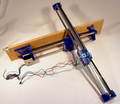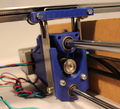Difference between revisions of "Projets:Lab:OpenEmbroiderer"
(Created page with "Original content in [http://wiki.electrolab.fr/Projets:Lab:brodeuse french]. Translation in progress. = Motivation = The idea is to transform a classic sewing machine into a...") |
(→Update from the CCC 2015) |
||
| (3 intermediate revisions by 2 users not shown) | |||
| Line 41: | Line 41: | ||
Work has to be done on needle sensor and presser foot (which highly influence thread strain. | Work has to be done on needle sensor and presser foot (which highly influence thread strain. | ||
| − | + | = Update 14/04/15 = | |
| − | + | ||
First tests with our diy motor drivers, based on the toshiba stk682 chip, 36V, 3A continuous, large enough to attach big power dissipator. The results are an encouraging speed/torque behavior, further acceleration tests must be done but going at a 10 stitches per second speed seems achievable. | First tests with our diy motor drivers, based on the toshiba stk682 chip, 36V, 3A continuous, large enough to attach big power dissipator. The results are an encouraging speed/torque behavior, further acceleration tests must be done but going at a 10 stitches per second speed seems achievable. | ||
| Line 49: | Line 48: | ||
| − | + | = Update 30/04/15 = | |
To show a working machine on the MakerFaire Paris we gave an extra boost on the project: | To show a working machine on the MakerFaire Paris we gave an extra boost on the project: | ||
| Line 59: | Line 58: | ||
Finally, yesterday (between midnight and 5pm), version 2 starts its first points :D | Finally, yesterday (between midnight and 5pm), version 2 starts its first points :D | ||
| + | |||
| + | <gallery> | ||
| + | File:MecaBreudeuseV2.png | ||
| + | File:CloseupMecaBreudeuseV2.png | ||
| + | File:SetphaneBreudeuseV2.jpg | ||
| + | File:PiedBreudeuseV2.jpg | ||
| + | File:LogoLabBreudeuseV2.jpg | ||
| + | File:CloseupLogoLabBreudeuseV2.jpg | ||
| + | </gallery> | ||
| + | |||
| + | = Update 14/08/15 = | ||
| + | |||
| + | * New firmware is out, the communication library is working, the machine is now remote controlled and stitches are streamed. | ||
| + | * Improvements in software, new stitches, remote control, but nothing visible since interface is not yet ready, you have to trust us :) | ||
| + | |||
| + | = Update from the CCC 2015 = | ||
| + | |||
| + | * during the CCC we're worked on a new foot (derived from a standard embroidery one) compatible with all machine, cheap, easily reproducible and with a pressing function that missed to ours precedent model. Results are much better with this improvement | ||
| + | * Now we're working a lot on the computer software (we gonna push it on a git repository as soon as possible) | ||
| + | |||
| + | <gallery> | ||
| + | File:Breudeuse_V02_front.jpg | ||
| + | File:Breudeuse_V02_back.jpg | ||
| + | File:breudeuse_logolab.jpg | ||
| + | File:breudeuse_logos_openembroider.jpg | ||
| + | </gallery> | ||
| + | |||
| + | A video of the machine at work (at maximum speed :p) is visible on our blog: http://blog.electrolab.fr/2015/08/20/electrolabccc2015/ | ||
| + | |||
| + | = Files = | ||
| + | |||
| + | All the code is in an early stage, so it's quite messy but already accessible. | ||
| + | * [http://downloads.electrolab.fr/breuhdeuse/openembroider_CCC2015.zip OpenEmbroider] software, no interface yet, approximative build system. | ||
| + | * The firmware is not accessible yet, because few drivers are not free and we need to rewrite it. But not a lot, It's coming really soon. | ||
| + | * [http://downloads.electrolab.fr/breuhdeuse/blend_V12.blend CAD] file, pressure foot is missing. All [http://downloads.electrolab.fr/breuhdeuse/stl.zip Stl] to print. | ||
| + | * Our [http://downloads.electrolab.fr/breuhdeuse/talk_OpenEmbroider_ccc2015_pdf.pdf slides] at CCC2015 lightning talks. | ||
Latest revision as of 13:37, 22 December 2015
Original content in french. Translation in progress.
Contents
[hide]Motivation
The idea is to transform a classic sewing machine into an embroiderer.
Mechanical modifications must be simples and reversibles (nondestructive).
The system is designed to be accessible and easily reproductible with common tools (no heavy machining like Electrolab's ones).
Tech
The system is quite simple:
- a position sensor to know if the needle is up or down, and move only if it's outside the fabric.
- a XY table with low precision requirements (0.1mm is already pretty good). In fact there is real constraints on the frame that hold the fabric, and the precision is hard to keep a good rigidity on every mechanical parts. It impacts maximum frame size and configuration of thread strain.
- motor control: 2 viable solutions: reprap drivers, which are easy to acquire and works out of the box but are expensive. Or a fully diy driver, with a custom driver chip and pcb, which is cheaper but harder to acquire. We have chosen this last solution, because the Electrolab may sell mechanical and electronic kits, which can give an alternative solution to those who can't order parts or create/solder pcb.
1st prototype
Not translated yet, sorry we are french, original page here
2nd prototype
In progress, its strengths:
- structure rigidity
- a cleaner mechanic, with standard parts (aluminum angle, reprap belts and pulleys, ...) or 3D printed in PLA. Its a step further in accessibility :)
- the belt/pulley XY table rather than ballscrew, provides increased speed but lower precision (we had too much of it anyway). Acceleration is quite the same because we have less torque but lighter moving mass.
- a compact motorization, which can be closed for a complete integration.
- a generic shape for an easier cross-vendor compatibility.
- really more beautiful.
For this version we are working with a Singer Curvy (a midrange sewing machine that we already have).
Work has to be done on needle sensor and presser foot (which highly influence thread strain.
Update 14/04/15
First tests with our diy motor drivers, based on the toshiba stk682 chip, 36V, 3A continuous, large enough to attach big power dissipator. The results are an encouraging speed/torque behavior, further acceleration tests must be done but going at a 10 stitches per second speed seems achievable.
The tested motor heats quite a lot and has no acceleration ramp, we must work on that.
Update 30/04/15
To show a working machine on the MakerFaire Paris we gave an extra boost on the project:
- First version of the presser foot and needle sensor part. A 2-in-1 part to reduce global complexity.
- Pcb and soldering of enough motor drivers version 2
- Firmware with acceleration ramp
- upgrade and 3D printed version of a lot of parts (frame, pressure foot, fixation clips, ...)
Finally, yesterday (between midnight and 5pm), version 2 starts its first points :D
Update 14/08/15
- New firmware is out, the communication library is working, the machine is now remote controlled and stitches are streamed.
- Improvements in software, new stitches, remote control, but nothing visible since interface is not yet ready, you have to trust us :)
Update from the CCC 2015
- during the CCC we're worked on a new foot (derived from a standard embroidery one) compatible with all machine, cheap, easily reproducible and with a pressing function that missed to ours precedent model. Results are much better with this improvement
- Now we're working a lot on the computer software (we gonna push it on a git repository as soon as possible)
A video of the machine at work (at maximum speed :p) is visible on our blog: http://blog.electrolab.fr/2015/08/20/electrolabccc2015/
Files
All the code is in an early stage, so it's quite messy but already accessible.
- OpenEmbroider software, no interface yet, approximative build system.
- The firmware is not accessible yet, because few drivers are not free and we need to rewrite it. But not a lot, It's coming really soon.
- CAD file, pressure foot is missing. All Stl to print.
- Our slides at CCC2015 lightning talks.












